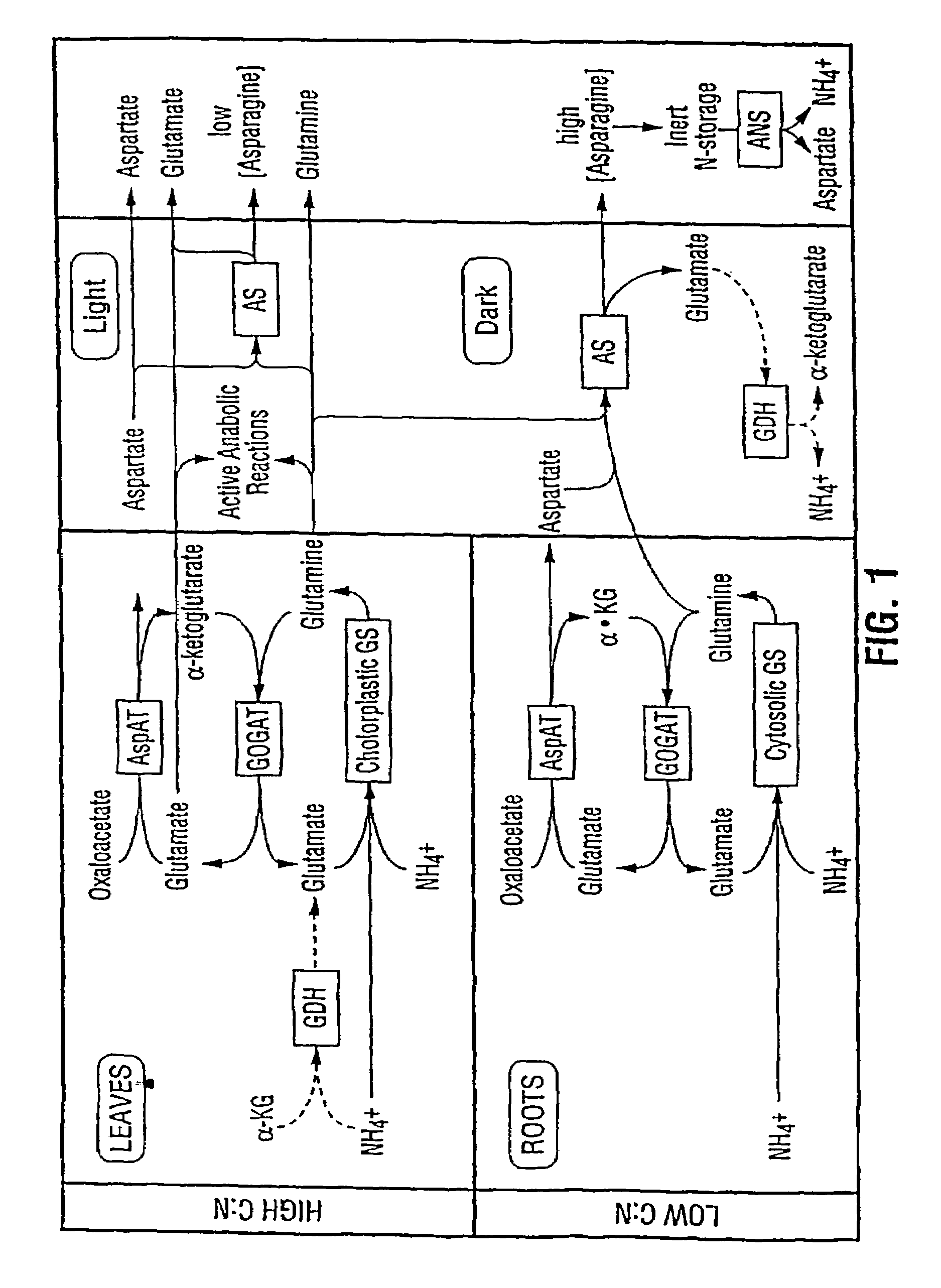Plants with enhanced levels of nitrogen utilization proteins in their root epidermis and uses thereof
a technology of nitrogen utilization protein and root epidermis, which is applied in the direction of plant peptides, angiosperm/flowering plants, enzymes, etc., can solve the problems of limited implementation of these strategies, environmental effects, pollution and health hazards, etc., and achieves enhanced nitrogen utilization, elevated levels of nitrogen utilization protein, and enhanced nitrogen utilization.
- Summary
- Abstract
- Description
- Claims
- Application Information
AI Technical Summary
Benefits of technology
Problems solved by technology
Method used
Image
Examples
example 1
Isolation and Characterization of Osmotic Stress-Induced Promoter
[0143]A Brassica napus (cv. Bridger) genomic DNA library (Clontech, Palo Alto, Calif.) was screened using standard techniques (Ausubel et al., 1989, Current Protocols in Molecular Biology, Wiley, Wiley, N.Y.) with the Pisum sativum 26 g cDNA (complementary deoxyribonucleic acid) clone (Guerrero et al., ibid), 32P-labelled with a Random Primer Kit (Boehringer Mannheim, Laval, Quebec). A 4.4 kb SalI fragment containing the entire btg-26 gene was subcloned into the commercially available pT7T3-19U vector (Pharmacia Canada, Inc., Baie d'Urfe, Quebec, Canada) for further analyses.
Identification of a Osmotic Stress-induced Promoter in Brassica napus
[0144]Several genes activated during drought stress have been isolated and characterized from different plant species. Most of these represent later-responding, ABA-inducible genes (reviewed by Skiver and Mundy, ibid.). Recently, however, an ABA-independent, cycloheximide-indepen...
example 2
Creation of Drought-Induced Nitrogen Assimilation Constructs
[0149]This step involved the production of either constitutive or drought induced AlaAT constructs and the introduction of them into Brassica napus using Agrobacterium mediated genetic transformation. The approach of introducing specific sense or antisense cDNA constructs into plants to modify specific metabolic pathways has been used in a number of species and to modify a number of different pathways. (See Stitt & Sonnewald 1995 for a review; Ann. Rev. of Plant Physiol. and Plant Mol. Biol. 46:341-368). The AlaAT cDNA was introduced under the control of three different promoters. (1) The CaMV promoter which has been shown to be a strong constitutive promoter in a number of different plant species; (2) the btg-26 promoter described in Example 1 and (3) the trg-3 1 promoter which was isolated from tobacco by Guerrero and Crossland (ibid.). The CaMV promoter should result in the constitutive overexpression of AlaAT whereas bt...
example 3
Growth of Primary Transformants Under Normal Conditions
[0157]T1 seed from the primary transformants of the groups CaMV / AlaAT and btg-26 / AlaAT were grown along with control, wild-type plants under normal conditions including planting at a 1 cm depth in 13 cm diameter plastic pots containing a soil and fertilizer mixture as described by Good and Maclagan (ibid.). These pots were placed in growth chambers under the following conditions: i) 16 h of 265 mmol m−2 s−1 provided by VITA-LITE U.H.O. fluorescent tubes, ii) day and night temperatures of 21° C. and 15° C. respectively, iii) relative humidity of 85%-97% and iv) daily watering with ½ strength Hoagland's solution. The only observable difference observed between the plants was the btg-26 / AlaAT plants had thicker stems when compared to the controls and CaMV / AlaAT plants. No significant differences were observed between the three groups in terms of growth rate, plant or leaf size or leaf senescence at identical time points, time to ma...
PUM
| Property | Measurement | Unit |
|---|---|---|
| relative water content | aaaaa | aaaaa |
| relative water content | aaaaa | aaaaa |
| pH | aaaaa | aaaaa |
Abstract
Description
Claims
Application Information
 Login to View More
Login to View More - R&D
- Intellectual Property
- Life Sciences
- Materials
- Tech Scout
- Unparalleled Data Quality
- Higher Quality Content
- 60% Fewer Hallucinations
Browse by: Latest US Patents, China's latest patents, Technical Efficacy Thesaurus, Application Domain, Technology Topic, Popular Technical Reports.
© 2025 PatSnap. All rights reserved.Legal|Privacy policy|Modern Slavery Act Transparency Statement|Sitemap|About US| Contact US: help@patsnap.com



